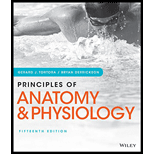
List the names and chemical symbols of the 12 most abundant chemical elements in the human body.
To review:
The names and chemical symbols of the 12 most abundant chemical elements in the human body.
Introduction:
Generally, human body is made up of 26 different chemical elements. Ninety-six percent of the body weight is due to four major elements: oxygen, carbon, hydrogen, and nitrogen. The next eight elements, for example, calcium, phosphorus, magnesium, sodium, potassium, chlorine, sulfur, and iron, are macronutrients and are considered as lesser elements. The rest of the 14 elements that are present in minute amounts are considered as trace elements, like aluminum (Al), fluorine (F), tin (Sn), etc.
Explanation of Solution
Human body is comprised of different types of chemical elements, out of which 12 are the most important. These are as follows:
| Chemical elements with symbols | Total percentage of chemical elements present in the body |
| Oxygen (O) | 65 |
| Carbon (C) | 18.5 |
| Hydrogen (H) | 9.5 |
| Nitrogen (N) | 3.2 |
| Calcium (Ca) | 1.5 |
| Phosphorus (P) | 1.0 |
| Potassium (K) | 0.35 |
| Sulfur (S) | 0.25 |
| Sodium (Na) | 0.2 |
| Chlorine (Cl) | 0.2 |
| Magnesium (Mg) | 0.1 |
| Iron (Fe) | 0.005 |
The human body has more oxygen by mass than any other element due to the water content present in the body, but more hydrogen is present by atom fraction than any other element.
Want to see more full solutions like this?
Chapter 2 Solutions
Principles of Anatomy and Physiology
- Name the principal chemical elements in living things and provide an important function of each.arrow_forwardAccording to chemist John Dalton, if one mole of nitrogen is combined with three moles of hydrogen to form one mole of ammonia (knowing that nitrogen, with an atomic number of 7, has an atomic mass of 14, and hydrogen, with an atomic number of 1, has an atomic mass of 1), then this compound will have an atomic weight (or molecular mass) of: 14 grams per mole (14 daltons) 17 grams per mole (17 daltons) 20 grams per mole (20 daltons) 22 grams per mole (22 daltons) 43 grams per mole (43 daltons)arrow_forwardDefine saltarrow_forward
- Identify the names of the following molecules.arrow_forwardSeveral substances found in nature or within living organisms themselves are essential to the life. Thus, for each of the following substances, please give a concrete example briefly describing how their properties make them essential to life. A) Acid (pH below 7) B) Lipidarrow_forwardFor each of the following chemicals, name the general class they belong to, discuss their solubility in water and explain why they are/are not soluble in water (note the numbers are all subscripts): a) CH3(CH2)26COOH b) KCl c) CH3OHarrow_forward
- Iodine has 37 known isotopes. Therefore, the atomic mass has a range of 108-144 amu. Which of the following statements concerning iodine is correct? A) The isotopes of iodine have between 55 and 91 protons. B) An atom of iodine can have between 55 and 91 neutrons. C) The isotopes of iodine will always have the same number of neutrons, but the protons can vary. D) The isotopes of iodine have between 108 and 144 neutrons, but the number of protons will not vary.arrow_forwardHow many grams of glucose (C6H2O6 molecular mass =180daltons) would be present in one liter of a 1M (molar) solution of glucose?arrow_forwardName several inorganic compounds.arrow_forward
- name common monoatomic anions and cations.arrow_forwardIdentify the elements that make up the following biomolecules. Write a yes or no in the box to indicate if the element is present or not. BIOMOLECULE carbohydrates proteins lipids carbon hydrogen nitrogen oxygen phosphorus nucleic acidsarrow_forwardApply the formula for the differences in electronegativities, for the following molecules, and define whether they are polar covalent, nonpolar covalent or ionic. Taking into account that: Non-polar covalent: greater than or equal to 0 but less than 0.7 Polar covalent: greater than or equal to 0.7 but less than 1.7 ionic: greater than 1.7 A)NO B)KCI C)F2 C)AsOarrow_forward
 Principles Of Radiographic Imaging: An Art And A ...Health & NutritionISBN:9781337711067Author:Richard R. Carlton, Arlene M. Adler, Vesna BalacPublisher:Cengage Learning
Principles Of Radiographic Imaging: An Art And A ...Health & NutritionISBN:9781337711067Author:Richard R. Carlton, Arlene M. Adler, Vesna BalacPublisher:Cengage Learning Biology Today and Tomorrow without Physiology (Mi...BiologyISBN:9781305117396Author:Cecie Starr, Christine Evers, Lisa StarrPublisher:Cengage Learning
Biology Today and Tomorrow without Physiology (Mi...BiologyISBN:9781305117396Author:Cecie Starr, Christine Evers, Lisa StarrPublisher:Cengage Learning


